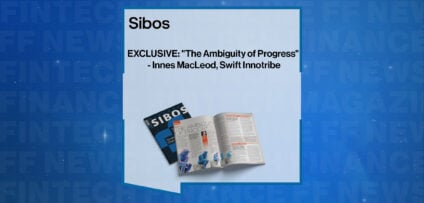Breaking News

EXCLUSIVE: “The Advantage of Ancient Errors” – Tony Fish in ‘Discover Sibos 2025’
Evolutionary hindsight reveals the hidden value of organisational ‘mistakes’, and it shows that timing, not novelty, determines competitive advantage, says Tony Fish
In December 2019, some humans possessed genetic variants that made them naturally resistant to a virus that didn’t yet have a name.
These weren’t new evolutionary responses; they were ancient adaptations to long-forgotten pathogens, carried silently for generations as apparent biological junk. When COVID-19 emerged, these seemingly ‘useless’ mutations suddenly became life-saving advantages. An echoing pattern played out in boardrooms worldwide, too. Companies that had maintained ‘excessive’ remote working infrastructure discovered it was essential for survival.
Organisations with ‘redundant’ supply chains found them to be a competitive advantage.
Risk management processes that felt ‘bureaucratic’ became the difference between continuity and collapse. We’ve been thinking about advantage entirely backwards. We obsess over building the next innovation when the capabilities that save us are probably already here, hidden in plain sight, waiting for their moment. Evolution operates on a principle that would horrify most management consultants: it hangs on to apparent mistakes. The human appendix, dismissed for decades as an evolutionary leftover, serves as a bacterial safe house, repopulating your gut microbiome after illness.
What appeared to be redundant architecture was, in fact, a sophisticated biological backup system.
But here’s what should make leadership pause: we’re making the same recognition errors in reverse. While evolution preserves ‘useless’ diversity, businesses systematically eliminate it in the name of efficiency. Consider Kodak’s digital imaging capabilities, developed in the 1970s but shelved because they threatened film profits. When digital photography exploded, Kodak possessed the foundational technology but had abandoned the organisational capability to deploy it. Their ancient error could have been their salvation, but they’d performed an organisational appendectomy on themselves.
Pharmaceutical companies that maintained ‘unprofitable’ vaccine production capabilities during the 2000s were the ones actually able to respond rapidly to COVID-19. Companies that had streamlined away these ‘inefficiencies’ found themselves entirely dependent on competitors who’d preserved what appeared to be wasteful diversity. Organisations that survive disruption don’t just have better capabilities; they recognise which of their existing, often overlooked capabilities have suddenly become relevant.
They don’t need to develop new advantages; they need to activate dormant ones. Evolution doesn’t optimise for current efficiency; it maintains optionality for unknown futures. And it isn’t random.
Researchers at the University of Nottingham analysed thousands of bacterial genomes and proved that certain genetic capabilities cluster together in predictable patterns, while others mutually exclude each other. This has profound implications for organisational strategy. Instead of blindly preserving all dormant capabilities and hoping some become valuable, companies should map which capabilities tend to activate together during disruption. The research reveals that some genes ‘never turned up in a genome when a particular other gene family was already there’, while others are ‘very much dependent on a different gene family being present’.
For business leaders, this means developing capability cluster maps. Which of your dormant capabilities work together? Which conflict? When environmental conditions shift, which portfolio of ‘ancient errors’ should be activated simultaneously for maximum advantage?
“Instead of framing unused capabilities as failures or inefficiencies, leaders need to position them as strategic options”
The age of hoping preserved inefficiencies will prove valuable at some point is giving way to predicting which combinations will create compound advantages when circumstantial change has begun. What seemed like evolutionary wisdom is becoming evolutionary engineering. Most organisations approach innovation expecting immediate returns, writing off failures as learning experiences. But what if those discontinued products, abandoned features, and underutilised capabilities aren’t failures at all? What if they’re options waiting for their context to arrive?
Touchscreen interfaces existed decades before the iPhone made them essential. Video calling was available long before remote work made it ubiquitous. Electric vehicles were invented alongside petrol cars but waited over a century for their moment. The technology wasn’t the constraint; timing is (was) everything. This reframes how we should evaluate innovation portfolios. Instead of measuring success by immediate adoption, we need to consider the breadth of future possibilities that our capabilities create. The question isn’t ‘will this work now?’ but ‘does this give us options when circumstances change?’.
The human resistance to preserved ‘waste’
But there’s a profound human challenge embedded in this approach. People have emotional relationships with their projects and deep resistance to maintaining what appears wasteful. Finance teams pressure for efficiency. Shareholders demand streamlined operations. Board members question redundant capabilities. The Netflix streaming technology sat dormant for years while the company focussed on DVD delivery, with internal teams advocating to abandon the ‘distraction’.
Netflix’s co-founder Reed Hastings later credited the company’s survival to maintaining streaming capabilities even when they seemed irrelevant to the core business. But imagine the internal resistance to that resource allocation during the DVD boom years. This creates a leadership paradox. The capabilities that provide future advantage often look like present waste. The people who champion preserving ‘useless’ capabilities often appear to resist necessary efficiency.
The teams working on dormant projects can feel undervalued and disconnected from organisational success. Managing this tension requires a different kind of organisational storytelling. Instead of framing unused capabilities as failures or inefficiencies, leaders need to position them as strategic options. Instead of measuring their success by current utilisation, organisations need metrics that capture option value and future readiness.
The advantage becomes even more powerful when we consider how ancient errors interact across organisational boundaries. Your company’s dormant capability might combine with a partner’s overlooked asset to create compound advantages that neither could achieve alone. During the early pandemic, companies with underutilised logistics capabilities partnered with organisations that had excess digital marketing reach, creating new service offerings that neither had planned.
Supply chain relationships that seemed purely transactional revealed hidden collaborative possibilities when circumstances demanded rapid adaptation. This network dimension transforms how we think about ecosystem strategy. Instead of just evaluating partners based on their current capabilities, we need to understand their portfolio of ancient errors. What dormant capabilities do they possess? How might our overlooked assets combine with theirs when market conditions shift?
The most resilient business ecosystems aren’t those with the most efficient partnerships; they’re those with the most diverse portfolio of dormant capabilities distributed across multiple organisations. The critical gap between possessing dormant advantages and deploying them is recognition speed. Just imagine what AI can do in this area?
Organisational peripheral vision is the ability to sense when dormant capabilities have become valuable. It needs someone whose job includes scanning for environmental changes that might make overlooked capabilities essential. Most organisations assign this responsibility to no one. Efficiency is therefore not optimising for survival, growth or thriving. The advantage of ancient errors demands different questions about competitive strategy. What capabilities do we currently consider non-essential that might become valuable if market conditions shifted? What would need to change for our overlooked assets to become competitive advantages?
Who in our organisation has responsibility for recognising when dormant capabilities become relevant? What early warning systems do we have for detecting contextual changes that make previously irrelevant capabilities essential? And perhaps most critically: what
inefficiencies’ are we eliminating that might be strategic options in disguise?
The advantage of ancient errors isn’t about preserving everything or avoiding difficult resource allocation decisions. It’s about recognising that in a world where change is accelerating, the capabilities that save organisations are probably already there, waiting in the wings of our current operations.
The question isn’t whether you have ancient errors that could become tomorrow’s advantages. The question is whether you’re paying enough attention to recognise them when their time comes, and whether you have the organisational courage to maintain diversity in an efficiency-obsessed world. The future may belong not to whoever sees truth most clearly, but to whoever builds the most effective fictions.
This article was published in Discover Sibos 2025, Page 14-15
People In This Post
- EXCLUSIVE: “The Advantage of Ancient Errors” – Tony Fish in ‘Discover Sibos 2025’ Read more
- EXCLUSIVE: “Game Changer” – Andy Lyons, Freemarket in ‘The Fintech Magazine’ Read more
- Binance Launches The Blockchain 100 Award to Honor Top Creators Driving Blockchain Innovation Read more
- MAPFRE AM Appoints Ismael García Puente as the New Deputy Director of Investment Strategy Read more
- Open Banking Startup Yavrio Named One of CNBC’s UK Top Fintechs 2025, Cementing Leadership in Enterprise Finance Read more














